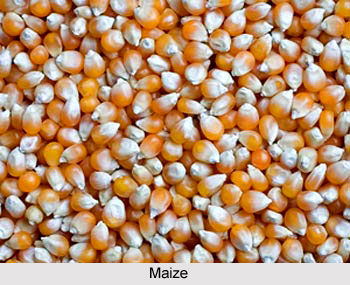 Maize is indigenous to America from where it was brought to India. Nevertheless, it is reaching popularity because of its high yields, and smooth flexibility with various soils and climatic conditions. Uttar Pradesh, Rajasthan, Bihar and Punjab are the major producers of maize. It is a cereal crop raised in India mainly for its grain. This food crop is used as a food grain for human consumption and is used for making starch. In some areas, it is raised only as a fodder crop. It is particularly raised in those areas that are free from frost for four and half months. Production has also leaped tremendously over the years.
Maize is indigenous to America from where it was brought to India. Nevertheless, it is reaching popularity because of its high yields, and smooth flexibility with various soils and climatic conditions. Uttar Pradesh, Rajasthan, Bihar and Punjab are the major producers of maize. It is a cereal crop raised in India mainly for its grain. This food crop is used as a food grain for human consumption and is used for making starch. In some areas, it is raised only as a fodder crop. It is particularly raised in those areas that are free from frost for four and half months. Production has also leaped tremendously over the years.
Dry winds are harmful to this crop. For optimum growth of maize, night temperature should not fall below 13 degree Celsius. Moreover, it requires 50 to 100 cm of rainfall during its growing period. In Karnataka and Punjab more than half of the land under maize is irrigated. Cool and dry weather that prevails after the rainy season enhances the ripening of the grain. Maize is raised in a variety of soils. However, it prefers well drained loamy soils rich in nitrogen. Excessive rainfall and floods damage this crop and reduces its yield. Thus, well drained lands are considered perfect for its cultivation. In the hilly regions, it is cultivated on the slopes.
Maize is cultivated as a kharif crop in the country. It is sown generally few weeks before the beginning of the summer monsoon rainy season. Maize is harvested generally in October when dry and relatively cool weather prevails. In Tamil Nadu, it is sown a few weeks before the onset of the winter rainy season generally before October. Maize is raised chiefly to the north of a line connecting Surat with Kolkata excluding of course, Kutch, western Rajasthan and Ladakh. In the north eastern region of India, it is raised mainly in Meghalaya. South of this line, it is grown in the northern districts of Andhra Pradesh and the neighbouring districts of Maharashtra and Madhya Pradesh.
Maize is the chief crop of Rajasthan and its adjoining states. Moreover, it is also some significance in some of the districts of Himachal Pradesh located south of the Himalaya Mountains and in a thin belt of the alluvial plain of Punjab, Uttar Pradesh, Haryana and Bihar running along the Sivalik Range. Darjeeling District of West Bengal and Garhwal Himalaya are major producers of Maize. However, India does not export Maize.




















